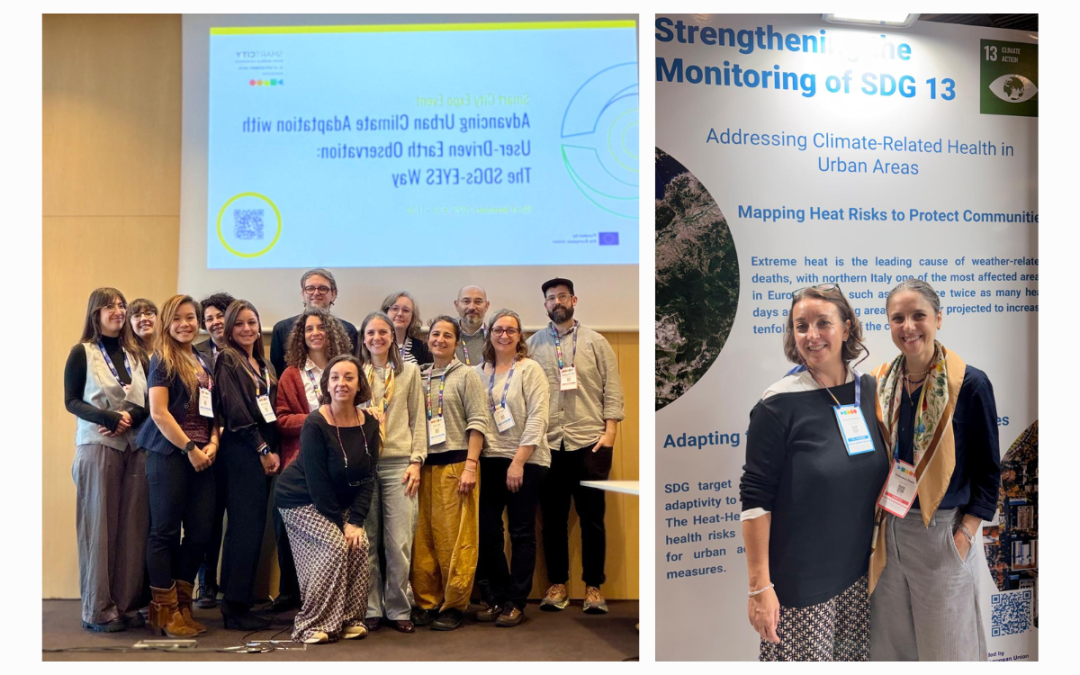On the 6th of November 2025, EARSC and T6 have organised the workshop “Advancing Urban Climate Adaptation with User-Driven Earth Observation: The SDGs-EYES Way” at the Smart City Expo World Congress 2025, showcasing how Earth Observation empowers smarter, more resilient, and sustainable cities. This leading global event on urban innovation gathered decision-makers, industry leaders, and innovators from across the world to shape the cities of tomorrow.
In this occasion, SDGs-EYES had the opportunity to showcasing how Earth Observation (EO) can help cities to become more resilient in the face of climate-related hazards and contribute to the monitoring of the SDG 13 Climate Action as well as provided a dedicated space to connect with urban practitioners and share solutions for resilient urban futures.In particular, throughout the activities of two pilots, we have explored: the mitigation dimension and the adaptation perspective.
- The mitigation dimension. The Pilot GHG Emissions from forest fires (City of Cosenza) illustrates the mitigation dimension, focusing on wildfires in peri-urban and forested areas. These fires release significant greenhouse gas emissions and smoke that travel into urban areas, degrading air quality, threatening public health, and disrupting infrastructure. Through a decision-support system built on Copernicus data, local authorities can monitor fire dynamics and emissions in near real-time, design land-use and risk management strategies, and ultimately reduce emissions while protecting communities.
- The adaptation perspective. Pilot Extreme temperatures risk (City of Turin) brings in the adaptation perspective, addressing the growing risk of extreme urban heat. By combining satellite data with socio-economic and health information, the risk assessment tool identifies where populations are most vulnerable during heatwaves. This supports immediate measures such as targeted health alerts and assistance to at-risk groups while also guiding long-term adaptation strategies, including urban greening and cooling infrastructure.
Together, these pilots show the dual value of EO: mitigating emissions from hazards that affect cities externally, and adapting urban environments to climate risks from within. By connecting mitigation and adaptation, the approaches tested in Cosenza and Turin provide scalable, replicable models for enhancing urban resilience across Europe, enabling authorities to shift from reaction to anticipation.
A second section of the workshop was then dedicated to explore how:
- engaging users early improves EO service design,
- those same user-driven insights can be elevated to inform policy, bridging the science–policy gap,
- to scale what works at local level into broader policy,
- to ensure EO-based solutions are embedded into governance processes and how local needs translate into service design.
Key Highlights
The event emphasised the importance of engaging users early to ensure EO services genuinely reflect local needs, strengthen the science–policy interface, and embed EO solutions into governance processes. By bringing together EO service providers, municipal representatives and citizen-science initiatives, the discussion underscored the need to scale effective local approaches into broader policy frameworks and to co-create climate solutions that are socially equitable, operationally relevant, and replicable across Europe.
However, funding remains the central challenge. While technical scalability and the transferability of solutions between cities are not obstacles, municipal-level financing is insufficient and cannot sustain long-term service uptake. Instead, funding should be anchored in national procurement processes that can allocate resources and services to cities more effectively. Institutional commitment is crucial to move from pilot initiatives to real integration within public administrations, alongside a shift in mindset that recognises EO not merely as data, but as a strategic asset for urban management and resilience.
The discussion confirmed how public–private collaboration is important, but public–civic collaboration is equally vital, as administrations need to work directly with citizens to ensure policies reflect real needs and benefit from ongoing community-led monitoring. Citizens not only inform policy but can also drive demand for action. Technical excellence alone cannot guarantee uptake; outputs must be simplified and co-designed with cities, whose engagement ensures co-ownership and trust-building around non-functional requirements. In particular, the experience of the City of Amsterdam illustrates this approach with its ambition to improve quality of life and advance climate resilience relies on EO services that support mobility planning, energy transition, monitoring of subsidence, air quality, green spaces, and urban heat. Through Space4Cities pilots, Amsterdam involves multiple departments—from construction and traffic to water management, health, and green maintenance—to co-design and validate EO solutions that integrate seamlessly into existing workflows and complement operational data. This demonstrates how co-ownership, cross-departmental collaboration, and iterative testing strengthen institutional commitment and ensure tools remain practical and user-driven.
Key enablers for policy adoption include strong public–private partnerships, multilevel governance that connects policymakers with local actors, and sustained collaboration with citizen science initiatives, as shared by IREC. Representative from the private sector, Constellr, commented that although technology funding is generally available, true scalability depends on governmental support, with national institutions purchasing EO solutions and making them accessible to cities.
The workshop concluded with a positive hope for stronger institutional commitment, sustained investment, and deeper collaboration across public authorities, industry, and citizens to ensure that EO becomes a fully embedded, widely accessible asset for urban resilience. By demonstrating that user-driven EO solutions are technically mature, socially relevant, and operationally scalable, the discussions reinforced a shared ambition to move beyond pilots toward long-term adoption, enabling cities across Europe to anticipate risks, design evidence-based policies, and advance climate action with confidence.

